Inside the UK's abandoned mansions
Magnificent mansions left to languish

Beyond the Point
Empty and unloved, some of the world's priciest properties have been forsaken by their owners and left to languish, from royal residences to presidential holiday homes and sprawling manor houses. But what led to their fall from grace?
We take a look inside some of the most expensive derelict mansions in the UK and uncover the mysteries behind their abandonment.
Billionaires' Row, London, UK

Glentree Estates
The Bishops Avenue, also known as Billionaires' Row, is one of London's most affluent and controversial streets. The prominent road can be found in Hampstead and around a third of the mansions along it have been left abandoned, with many of them having fallen into ruin.
Owned mostly by foreign investors who leave their homes uninhabited, these luxe properties are now in a sad state of repair.
Billionaires' Row, London, UK

Beyond the Point
Many of the 66 homes on Billionaires' Row were built in the late 1970s, with around twenty of them now standing entirely derelict, despite being some of the most valuable homes in Britain.
In fact, in 2008, Toprak Mansion on The Bishops Avenue claimed a new record as the most expensive home ever sold in the UK at the time. The estate changed hands for £50 million ($64m).
Billionaires' Row, London, UK
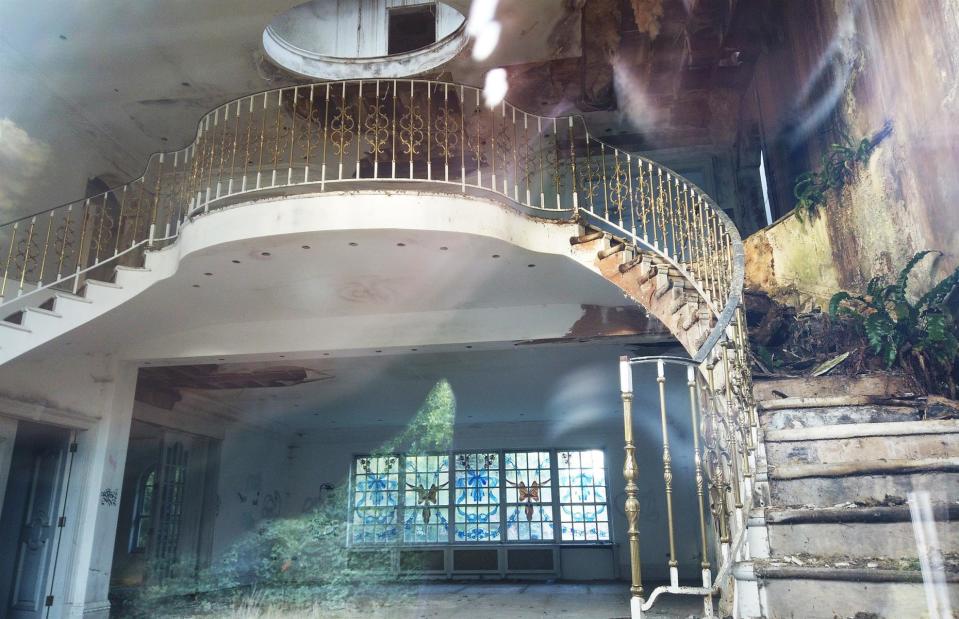
Beyond the Point
Captured here by explorers Beyond the Point, this empty hallway is falling apart, with a caved-in ceiling that has let in the elements. However, it's easy to see reminders of the home's former grandeur still in place, such as the gold bannister and stained-glass windows within this cavernous hallway.
In 2022, students also explored one of the properties known locally as 'The Towers', sharing their findings on TikTok.
Billionaires' Row, London, UK
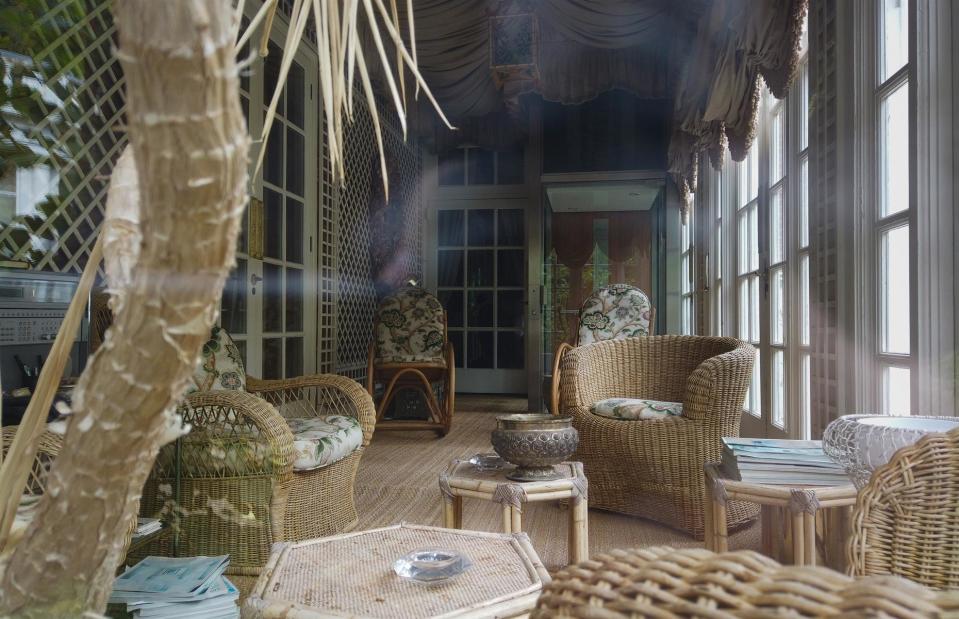
Beyond the Point
As unbelievable as it may seem, some of the homes have been left untouched for over 30 years. This conservatory looks like the owners have just upped and left, with an ashtray still perched on the rattan table and faded magazines stacked high.
The Bishops Avenue has been dubbed "one of the most expensive wastelands in the world" by developer Anil Varma, who owns a property on this notorious street.
Billionaires' Row, London, UK

Beyond the Point
Residents past and present include the super-rich Sultan of Brunei and Justin Bieber, who reportedly rented one of the street's more luxurious homes in 2016 for a whopping £108,000 ($137k) a month.
What was once the ultimate place to live in London has become an entire street of wasteful ruins and decaying buildings, that are said to be collectively worth £350 million ($445m).
Hamilton Palace, Sussex, UK

Chris Gorman / Getty Images
In the English town of Uckfield, Sussex, rests Hamilton Palace, a spectacular private mansion. Or at least it was supposed to be when building started four decades ago. Despite work beginning in 1985, scaffolding remains in place – a stark reminder of the home's disastrous construction journey.
With two huge wings, a golden dome and a lakeside mausoleum, the palace is larger than Buckingham Palace. It was commissioned by disgraced businessman, Nicholas van Hoogstraten, who is said to have made his fortune in property, mines, art and money-lending.
Hamilton Palace, Sussex, UK

Chris Gorman / Getty Images
Van Hoogstraten became Britain’s youngest millionaire at the age of 22 in the swinging sixties and his net worth has been placed as high as £800 million ($1019m), according to Sussex Live.
Costing around £40 million ($50.9m) to build, a pricey £118 million ($150m) in today's money, Hamilton Palace was once one of the most expensive (and largest) private houses in Britain for a century, even though no one has ever lived there.
Hamilton Palace, Sussex, UK

Andrew Hasson / Alamy Stock Photo
According to the palace's architect Anthony Browne, van Hoogstraten has a reputation for being a difficult character. In fact, in one documentary, he was quoted as saying that he was prepared to do "whatever is necessary" to get what he wanted.
Unsurprisingly then, the construction of the palace caused plenty of disputes with neighbours, after van Hoogstraten decided to remove a public footpath that runs through the estate. Yet there are perhaps more sinister reasons why the house has remained half-finished, with construction materials strewn across its oversized rooms...
Hamilton Palace, Sussex, UK
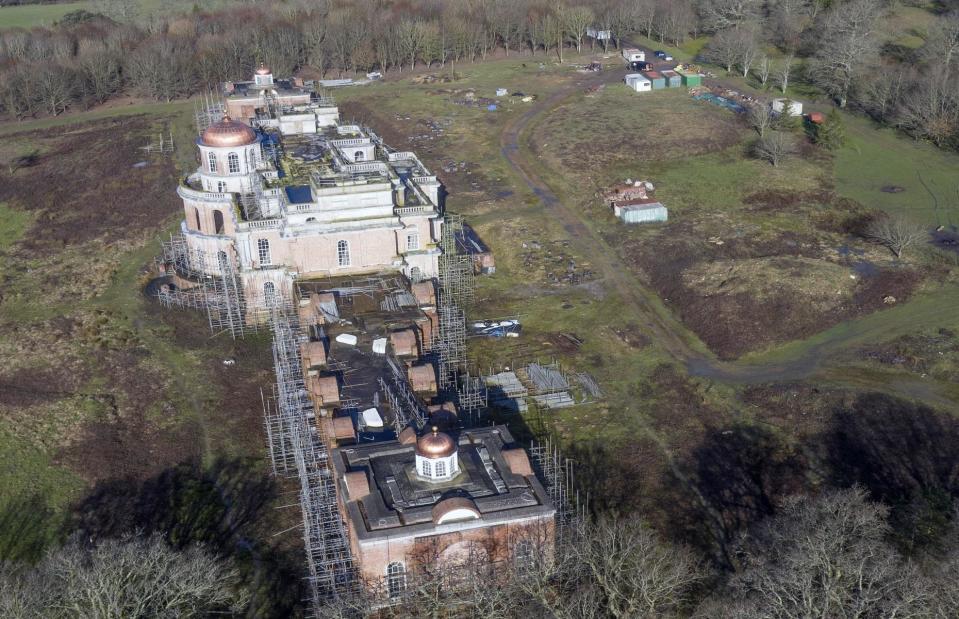
Chris Gorman / Getty Images
In a shocking turn of events, in 2002 Mr Hoogstraten was sentenced to 10 years in jail for the manslaughter of his business rival Mohammed Raja.
The conviction was later quashed on appeal, but van Hoogstraten was later ordered to pay Raja’s family £6 million ($7.7m) in damages, of which van Hoogstraten said they “would not see a penny”, according to reports. Shortly after this, the construction of Hamilton Palace was put on hold.
Hamilton Palace, Sussex, UK
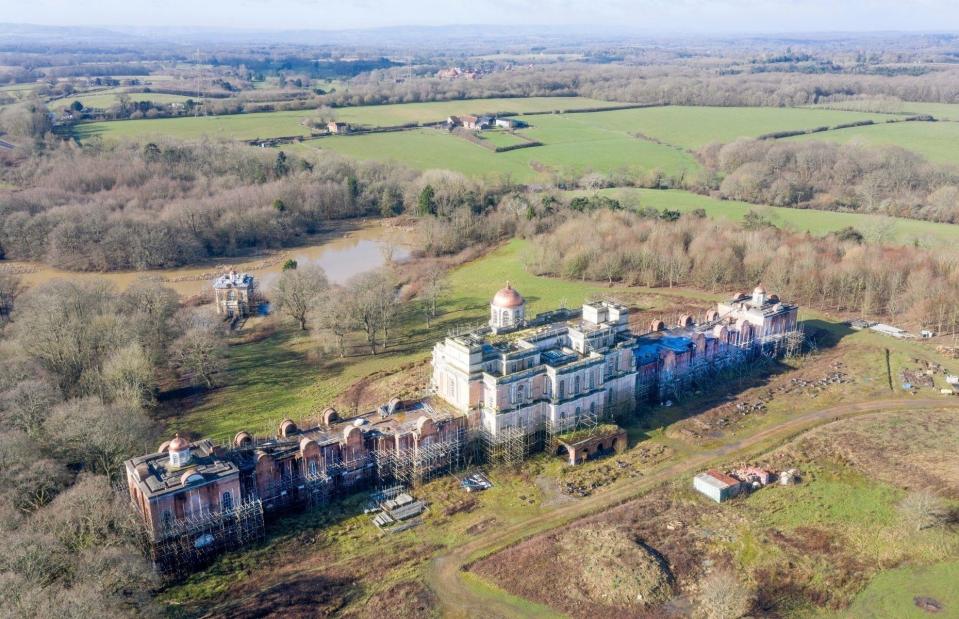
Chris Gorman / Getty Images
Since then, the dilapidated building, encased in scaffolding and standing in sharp contrast to the green and pleasant surrounding countryside, has remained pretty much unchanged.
Van Hoogstraten claims his empire has since been broken up and is now in the hands of his five children, as is his multi-million vanity project, which is known by locals as 'the ghost house of Sussex'.
18th-century townhouse, London, UK

Knight Frank
Completed in the mid-18th century, this spectacular townhouse can be found in the heart of one of London's most prestigious neighbourhoods, Mayfair.
Close to Hyde Park Corner, the Grade II listed building would once have been the home of a very wealthy and socially important family, but somewhere along the lines the lavish residence was left to languish.
18th-century townhouse, London, UK

Knight Frank
While the building’s prominent and refined façade boasts plenty of kerb appeal, the interior is seemingly endless and overflowing with elegant period details. Arranged over six floors, there are 14,000 square feet of accommodation. As soon as you step through the front door, you're greeted by drama – just look at this stunning marble staircase.
18th-century townhouse, London, UK

Knight Frank
While we don't know the full history of the property, we do know that at some point it was converted from a mansion into an office building. Sadly, when it was vacated by the company – or companies –occupying it, the structure was stripped and left to deteriorate. Holes and signs of damage can be seen in the floors, walls and ceilings, revealing that the building needs major restoration works.
18th-century townhouse, London, UK

Knight Frank
Yet despite its rundown state, every room still showcases preserved original features, such as beautiful crown mouldings, sash windows, fireplaces and light fixtures. One of the most impressive features of the historic townhouse is its statement roof light, which decorates the very top floor, flooding the stairwell and hallway with light. Plus, many of the upper-floor windows allow for far-reaching views over Green Park.
18th-century townhouse, London, UK

Knight Frank
Last listed for sale via Knight Frank for a whopping £30 million ($38m), the impressive property already has planning permission in place to be converted into a luxurious 10-bedroom home, complete with a basement swimming pool and wellness zone, a library, a chauffeur’s office and a movie theatre.
Kinmel Hall, Conwy, UK
![<p>John Ingleby / Wikimedia Commons [Public domain]</p>](https://s.yimg.com/ny/api/res/1.2/qZSLKg4l_IEWl4DBr0W0dg--/YXBwaWQ9aGlnaGxhbmRlcjt3PTk2MDtoPTYxOQ--/https://media.zenfs.com/en/loveproperty_uk_165/b6ae2b3398e2d14cfd1f45854acf00b8)
John Ingleby / Wikimedia Commons [Public domain]
Like Africa's Versailles in the Jungle, Kinmel Hall, which is nicknamed the 'Welsh Versailles', has been left to decay, though it isn't in quite as bad shape as Mobutu's former palace. The splendid château-style mansion dates from the 1870s. A 'calendar house', it had 365 rooms at its height, one for every day of the year. A room was even dedicated to ironing newspapers at one time.
Kinmel Hall, Conwy, UK

Colliers International
The sprawling country house was built for copper tycoon Hugh Robert Hughes, who became known as HRH due to his suitably regal lifestyle. The mansion passed through several families and was last used as a private home in 1929, when it was sold to the highest bidder and converted into a boy's school.
Kinmel Hall, Conwy, UK

Colliers International
Kinmel Hall became a spa for rheumatoid sufferers in the 1930s and a military convalescent home during the Second World War. The mansion changed hands again after the war when it reopened as the Clarendon School for Girls.
A fire in 1975 forced the school to relocate and Kinmel Hall was acquired and restored by businessman Eddie Vince, who used it as a Christian conference centre.
Kinmel Hall, Conwy, UK
![<p>Northernhenge / Wikimedia Commons [Public domain]</p>](https://s.yimg.com/ny/api/res/1.2/f7pDeEtzfuLGZQE1S2WVPg--/YXBwaWQ9aGlnaGxhbmRlcjt3PTk2MDtoPTYxOQ--/https://media.zenfs.com/en/loveproperty_uk_165/522c5f89dce3e29b0ee4dd96bfa37a42)
Northernhenge / Wikimedia Commons [Public domain]
There were plans to transform Kinmel Hall into a luxury hotel, but the project never came to fruition. In 2011, a mystery buyer bought the mansion for a bargain £1.5 million ($1.9m), intending to develop the elusive hotel. Ambitious plans were unveiled in 2012 but work on the new hotel failed to commence.
Kinmel Hall went even more downhill. Looters descended on the abandoned property in 2013 and made off with a set of carved wooden panels gifted to Hughes by Queen Victoria, who is believed to have stayed at the house in the 1870s.
Kinmel Hall, Conwy, UK

Colliers International
Kinmel Hall was added to the Victorian Society's Top 10 Most Endangered Buildings list in 2015 due to its worsening state. However, in May 2021 the estate was sold to a local resident at auction for £940,000 ($1.2m), who claimed they wanted to see Kinmel Hall 'restored to its former glory'. Not much has happened in the interim as far as we can tell.
However, in January 2023 Conwy council served an enforcement on the owners to remove a set of glamping pods which were damaging the grounds. Hopefully, the historic home will receive the love and attention it needs soon.
Hook End Manor, Oxfordshire, UK
![<p>Des Blenkinsopp / Wikimedia Commons [CC BY-SA 2.0]</p>](https://s.yimg.com/ny/api/res/1.2/nvddDQBDKQ89.PWSHzdgpA--/YXBwaWQ9aGlnaGxhbmRlcjt3PTk2MDtoPTYxOQ--/https://media.zenfs.com/en/loveproperty_uk_165/f25d31164e862d8b7d50b5bfe5e9ec51)
Des Blenkinsopp / Wikimedia Commons [CC BY-SA 2.0]
Destined to later become the home of Pink Floyd's David Gilmour, this storied Elizabethan mansion in Oxfordshire was built in 1580 for the Bishop of Reading, and is thought to have served as a psychiatric asylum during its long history.
Selfridges owner Sir Charles Clore acquired the 11-bedroom manor house during the 1950s and sold it on in 1972 to Alvin Lee, lead singer for the band Ten Years After, who built a recording studio in the barn.
Hook End Manor, Oxfordshire, UK

Trevor Bishenden / TrevBish Photography
Lee put down several albums at the studio and even used the indoor tennis court as an echo chamber. He let go of the property, which was snapped up by rock star David Gilmour of Pink Floyd, in 1980.
The band's giant inflatable pig was stored on the premises and two Pink Floyd LPs were recorded in the studio. Gilmour sold up in 1986 and the manor house and recording studio eventually passed to Frankie Goes to Hollywood producer, Trevor Horn.
Hook End Manor, Oxfordshire, UK

Trevor Bishenden / TrevBish Photography
Horn transformed the property into Hookend Productions, which was the UK's most luxurious recording venue from the late 1980s to the 2000s. An impressive line-up of musicians recorded singles and albums there, including Rod Stewart, the Manic Street Preachers, Seal and the Smiths.
During his stay at the manor, Morrissey claimed to have been visited by the ghost of a monk. The phantom would appear during the wee hours of the morning as if to wake people to pray.
Hook End Manor, Oxfordshire, UK

Trevor Bishenden / TrevBish Photography
In fact, rumour has it that David Gilmour gave up the property because his wife Ginger was so freaked out by the paranormal activity, that she refused to stay there. In 2006, a tragic accident at the property forced Horn to sell up, and the property was bought by producer Mark White in 2009 for £12 million ($15.2m).
Hook End Manor, Oxfordshire, UK
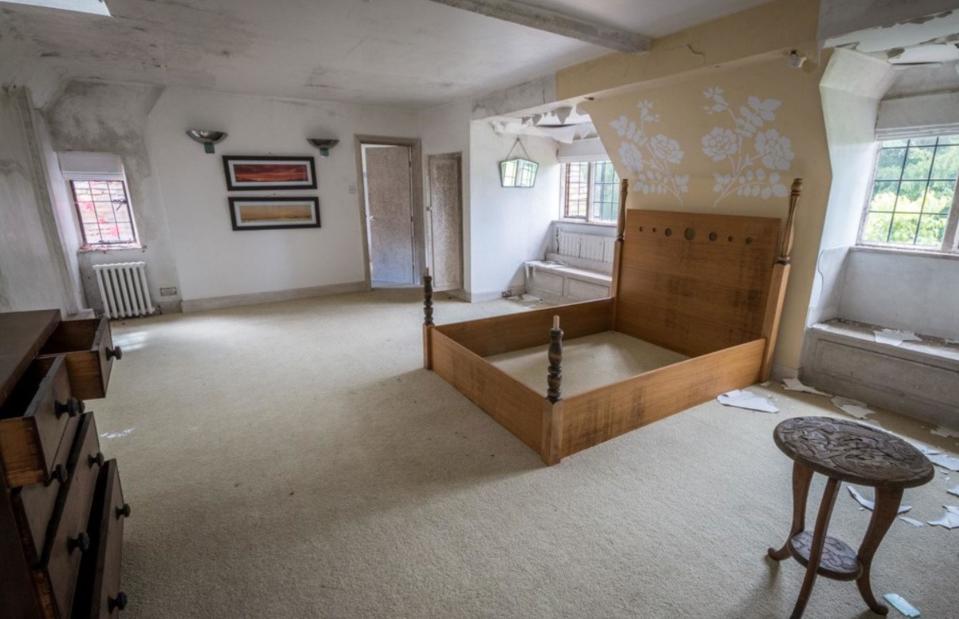
Trevor Bishenden / TrevBish Photography
White invested in the studio, but the house lay neglected for years. Photographer Trevor Bishenden captured the dilapidated interiors in 2020 when the manor appeared to be completely abandoned with rising damp and peeling wallpaper.
Fortunately, reports say the house is currently undergoing a renovation and is in the process of being brought back from the brink and turned into a luxury pool complex.


